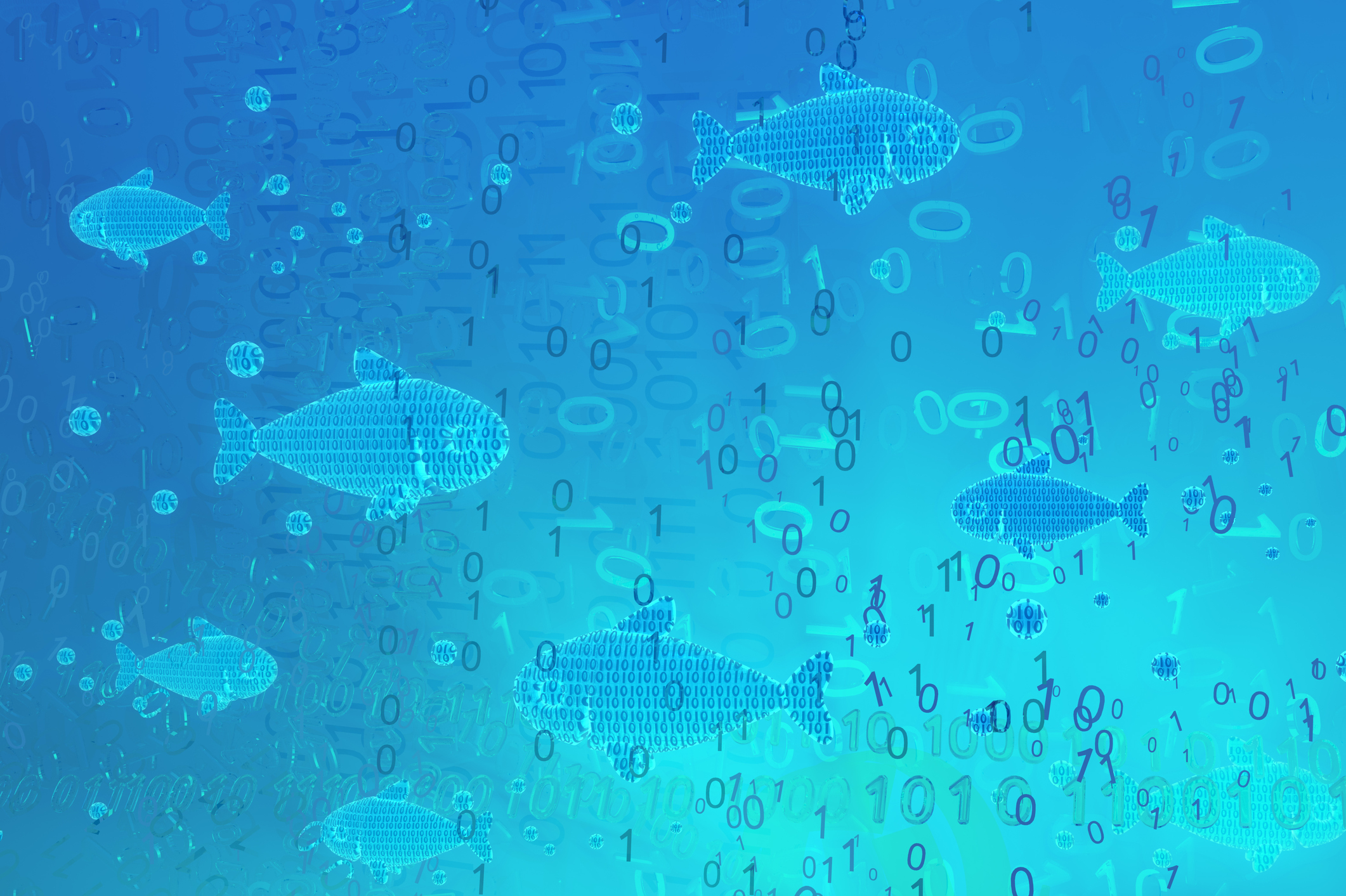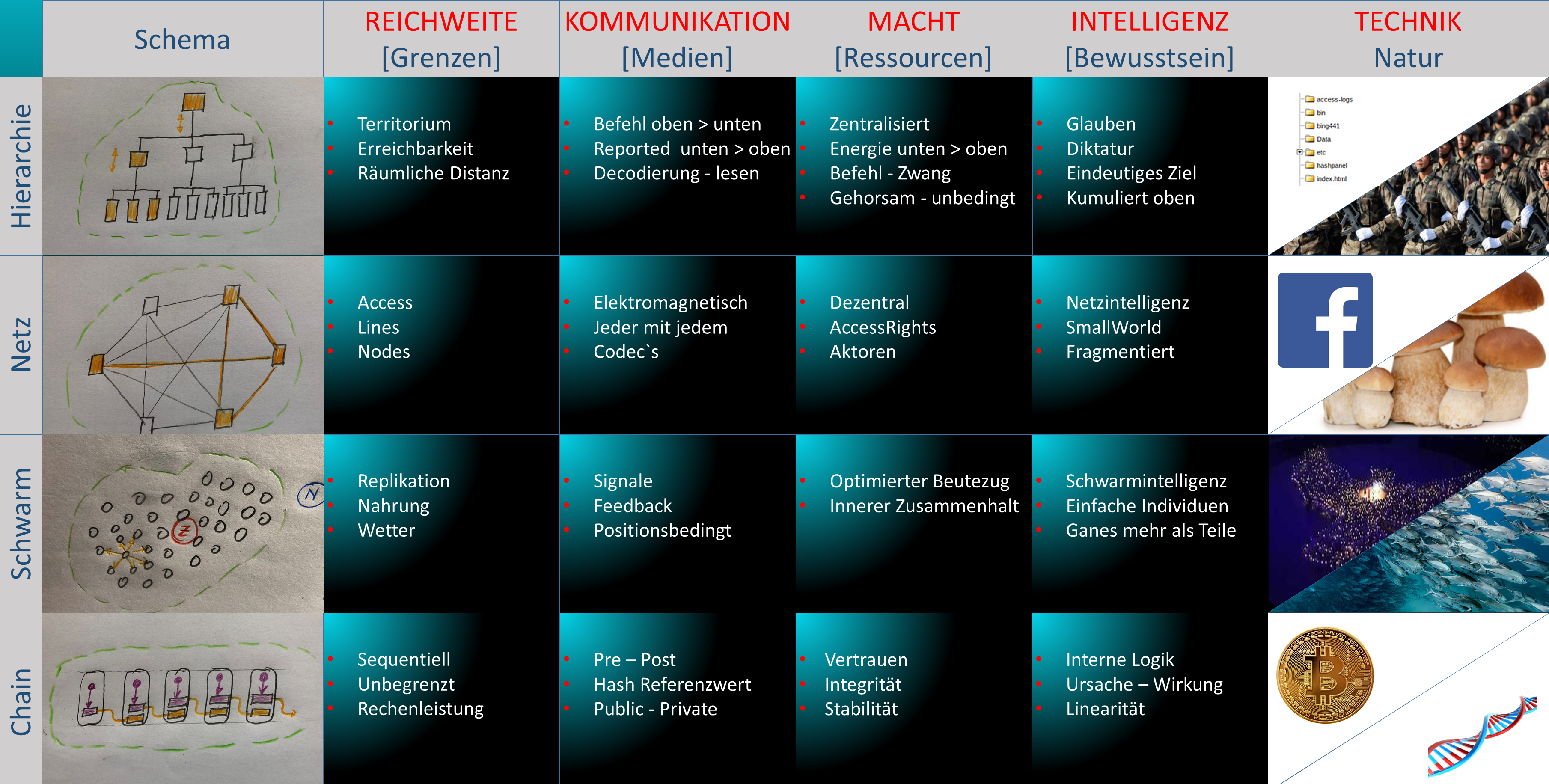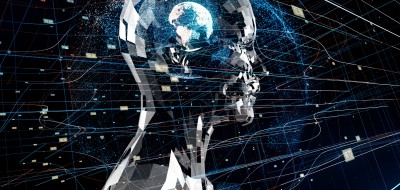How is the world structured? From parts that make a whole, and which in turn is a particle of an even greater whole. The distinction is therefore in the arrangement of the parts and their relationship with each other. With four classes of structures you can explain a large part of the world quite well. These are the hierarchies, the nets, the swarm and the chain.
Every structure has the properties that determine it. You want to know how big a system is, which limits and ranges it has. These depend on the environment and the substance. The more material, the bigger and the more virtual / spiritual, the smaller. A structure is created only by the specific arrangement of the parts, how they are linked to each other and by what method they exchange (energy and data). With the understanding of communication and relationships in a system, much of its structure is already revealed. Systems need resources to survive. If you want to know where the power of a system is, you just have to follow the flow of resources. This is very obvious with money. The one with the most money also has the biggest influence. The rapid development in the AI field also requires clarification whether a system is intelligent or even has consciousness. The picture shows a two-dimensional description of structures. The following is a slightly more detailed description of the individual schemes, each with an example from the real world and one from the digital world.
Hierarchy: Social structures with a monarch at the top were the dominating structure over millennia. In many cases, the “supreme” god-like skills (Pharaoh) were awarded. All serfdom, feudal rights and the decision on life and death were associated with this. The hierarchical structure was and still is a model of success in the mammalian world. Even the organization of modern, successful companies is still hierarchical. The structural advantage of hierarchs lies in their clear orientation to the leader and the associated communication line. Since Roman times armies are organized hierarchically (legions). The commands run from top to bottom. Reported is exactly the opposite.
Hierarchies have their borders in the territory. All parts that are within a temporal and spatial distance can belong to it. Commands issued via messengers traveling on foot have limits. This is completely defused by today’s communication technology. Hierarchies can span the globe. Like the Catholic Church, Microsoft or the CIA.
All power is centralized. The parent has command and the subordinate is required to obey. There is over- and subordination. In the case of resource allocation, conversely, it runs from bottom to top. It was always the Emperor who intervened in the war booty. This is also easy to recognize with digital hierarchies, such as the folder system of computers. The administrator simply has the most rights and assigns them as roles to the employees. The exact role definition is also an advantage of hierarchies. Everyone, whether tailor, minister, designer, etc., has his role and with it the position in the hierarchy.
The knowledge in the system is distributed, but can be cumulated very quickly upwards. If the communication channels are short and fast, then you have to deal with a central intelligence. The leader, CEO, Pope, etc. knows everything. The cohesion of a hierarchy is guaranteed by force (dictatorship) and / or by faith (salvation). Companies with tight, hierarchical organization are very fast in their decision-making. The danger is a subjective / emotional misjudgment of the leader.
Networks:
If someone had asked for the term “net” 50 years ago, the answer would probably have come: spider web. Today you come almost exclusively in contact with technical networks and especially if they do not exist – “no mobile network”. A network, whether natural or artificial, is made up of nodes and edges (connections). The more nodes, the denser and the more edges, the more communicative it is. A network is a structure that consists of just these two components and is also capable of communication. Would there even be a spider web, that’s not communicative? The spider builds her web as a tool for hunting. The animal is sitting somewhere in the net, and then when an insect is trapped, it comes to a violent shock and the spider knows she has caught something. Thus, the web of spiders is also capable of communication. It signals over pressure waves. The largest and most powerful of all known networks is currently the human brain. There, data are processed via electrochemical processes and processed at the nodes (neurons) analogously via input threshold values and output function. Probably the largest network, the Universe, is not yet known as such a structure. From the universe you only know the parts (suns, planets). But you can not establish a communicative connection with each other. Although it is very visible, in the form of light. It could well be that light encoded data is included as well.
If the nodes are inherited in a hierarchy, they can be accessed by the network for everyone. Technical networks exchange their information on an electrometric basis. The data are coded, so every actor needs codecs. Basically everyone is connected to everyone. On the one hand, this leads to network intelligence because all knowledge is decentralized and everyone can potentially access it. This is always shown with the example of the YouTube condition and repair manuals. On the other hand, the network is limited by the relationship ability. People can maintain a relationship for efficient communication with about 12 people in a context. Being linked to the phenomenon of all and still being subject to the interlocking of relationships creates the small-world structure. A network where we have many local relations and few long distance connections. The most notable example is Facebook. An essential barrier to entry into a network is the willingness to introduce your own services in advance and without commitment for consideration. The reward for their own efforts comes late. This can also be shown again using the example of social media. Only if you have a high enough number of followers, you will get money (YouTuber). The existence and the own commitment are nevertheless still too few. You also have to have access rights. In many cases this can be acquired by simply paying a membership fee (Netflix). It is more difficult to get AccessRights in networks that are not known but still exist. Who knows the Red Riding Hood network today? Probably very few. So anyone who is only on their own network is missing the world.
Swarm:
The term “swarm intelligence” is widespread – although it is hardly known what it is. Very well known are fish and bird swarms. Less well-known, but very threatening, the locust swarms. Swarms are formed solely and solely because they have greater efficiency in their raiding and thus higher survival probabilities. The individual swarm member must first make sure that it always has the right distance to all its neighbors. Secondly, the basic direction of movement is focused on a virtual center, and thirdly, as soon as food appears on the periphery, it moves in that direction. This creates the beautiful patterns of swarms and their obvious random movement. Now we know that this is not accidental, but that the swarm follows its prey. The range of a flock depends on its replication ability, the food and the environmental conditions (weather with grasshoppers). The communication within a swarm takes place via signals and feedback and changes in position. The power of a swarm consists in its optimized foray and inner cohesion. The swarm intelligence itself is formed by simple, less intelligent individuals and is considered a prototype for “the whole is more than the parts”.
Chain:
A structure according to the pattern “the chain” has become known in the term of the technical “block chain”. This is understood to mean an explicit, sequential arrangement of parts, each consisting of a predecessor and successor (Predecessor / Successor). This order is basically unlimited. The technical blockchain is limited by memory and computing power – but is in the exabit range. The communication within this structure takes place between pre- and post and the successor always has a reference to its predecessor. These reference values are not simple numbers, but represent the particular hash value of the blog content. The higher the requirements for the key, the higher the computing power. This is currently being expressed in terms of the power requirements of the mining farms. A chain structure is always used when it comes to trust, integrity, and stability. This has adapted to the evolutionary nature and equipped the living beings with a genetic program – which always refers to the predecessor and is very stable. The blockchain itself has become very popular through the crypto-currency Bitcoin. In the future, this structure will be used in all value-based transactions that run under the pattern of a cause-and-effect arrangement. The cause could be a seller selling his home and the effect could be a buyer buying just that. It has to be clarified if the seller is the rightful owner – so you have to trace the chain and you also have to know if the buyer has the necessary funds. The Blockchain is used for a variety of contracts such as land, stocks, commodities, licenses, and more. to be used. Compared to networks and hierarchies, a chain has a very simple internal logic and is characterized above all by linearity. With this structure, it is now possible to bring trust into the digital world. Data would be traceable backwards. Changes in hindsight almost impossible – I can not change the genes of my great-grandfather anymore. In my own blog, I have a private and public part, where I can decide on the relationship myself.








 Deutsch
Deutsch English
English